Container gardening offers a versatile and visually appealing way to enhance commercial and high-end residential properties in Australia. By carefully selecting plants that are suited to the local climate and soil conditions, you can create stunning outdoor spaces that showcase your property’s unique character. This article will explore essential factors to consider when choosing plants for container gardening in Australia, including climate, sunlight, soil type, and aesthetic preferences.
Introduction
When selecting plants for your planters, there are a number of factors to consider:
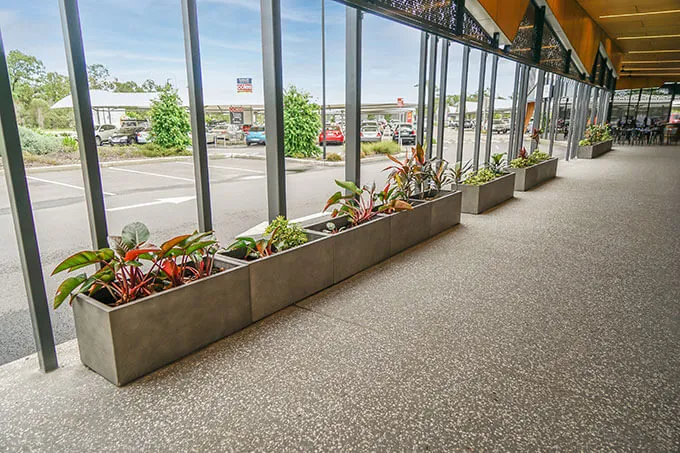
Climate Compatibility
Select plants that thrive in the local climate conditions. Australia’s diverse climate zones mean that what works in Sydney might not work in Perth. Drought-tolerant plants like succulents and native species are often ideal for commercial projects due to their low maintenance needs.
Design Considerations
The plant selection should align with the intended design aesthetic. For example, architectural plants like agaves or yuccas work well in modern designs, while softer, flowering plants like lavender or gardenias may suit a more traditional setting.
Functional Aspects
Consider the functional aspects of the plants chosen, such as privacy, shade, or air purification. In commercial settings, plants might also need to withstand pollution or heavy foot traffic.
Maintenance Requirements
Residential projects may allow for more labour-intensive plantings, while commercial projects typically benefit from low-maintenance options. Understand the expectations for maintenance and choose plants accordingly. Be realistic about the level of care you can provide. For low-maintenance options, consider hardy plants that require minimal watering and pruning. If time or expertise is a concern, hiring a garden maintenance service can ensure your plants remain healthy and vibrant.
Plants for Privacy
Many clients come to me seeking ways to block out neighbours and create private outdoor spaces using plants. Choosing the right container plants for privacy depends on several factors, including your climate, desired height, and maintenance preferences. Here are some popular options for different Australian climates:
General Options for Most Australian Climates:
Lilly Pilly (Syzygium smithii): A classic choice, known for its fast growth, dense foliage, and attractive flowers and berries.
Pittosporum: Offers various varieties with different leaf colors and growth habits. Tolerant of different conditions.
Bamboo: Provides a quick and effective screen, but can be invasive if not carefully managed. Choose clumping varieties for better control.

Hardenbergia: A beautiful native climber that can be trained on a trellis or fence for a fragrant and colourful screen.
For Warmer Climates
Grevillea: Many varieties are fast-growing and drought-tolerant, offering privacy with attractive flowers.
Banksia: Another native option with striking foliage and flowers, suitable for coastal areas.
For Cooler Climates
Photinia: Provides a dense, evergreen screen with attractive new growth.
Japanese Holly: A classic hedging plant with a formal appearance and good disease resistance.
Best Ornamental Plants for Containers in Australia
Australia’s diverse climate means there’s a wide range of ornamental plants suitable for containers. Here are some popular choices:
For Warmer Climates
Geraniums: Classic, colourful, and easy to care for.
Hibiscus: Tropical flair with large, showy flowers.
Bougainvillea: Vibrant climber that can be trained into a compact shape.
Correas: Native Australian shrubs with colourful flowers and low maintenance.
For Cooler Climates
Pansies and Violas: Winter bloomers that add colour to your patio.
Cyclamen: Delicate flowers in a range of colours.
Azaleas: Beautiful flowering shrubs that thrive in cooler climates.
Succulents: Low-maintenance and drought-tolerant, perfect for busy lifestyles.
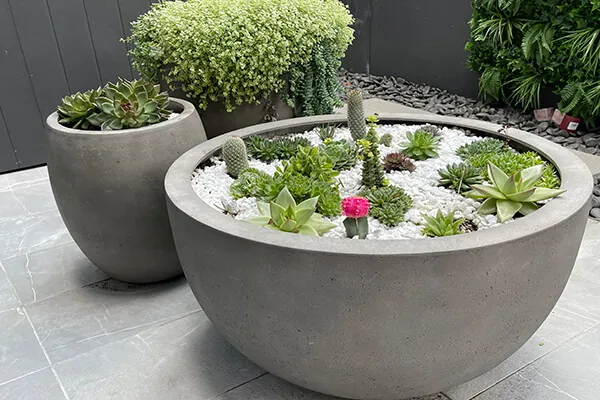
Orchids: Exotic and elegant, adding a touch of luxury.
Herbs: Combine beauty and practicality with culinary herbs like basil, rosemary, or thyme.
Drought-Tolerant Plants
If there’s no drip irrigation where the containers will be situated, you’ll need to specify drought-tolerant plants for the pots. It doesn’t mean they need no water at all, but they’ll survive more readily with sporadic watering. With Australia’s climate, particularly its arid and semi-arid regions, makes drought-tolerant plants a must-have for many gardens. Here are some excellent choices for growing in pots:
Succulents and Cacti
These are classic choices for a reason. They’re designed to store water, making them incredibly resilient to drought.
Some general favourites are: Aloe vera, Echeveria, Haworthia, Sedum, Cactus (various types)
And these ones are particularly suited to planters:
Dwarf Jade Plant: This succulent is perfect for pots and requires minimal water, making it an excellent choice for drought-prone areas.
Zanzibar Gem (Zamioculcas zamiifolia): Renowned for its resilience, this plant can thrive in low-light conditions and requires infrequent watering.
String of Pearls (Senecio rowleyanus): A unique trailing succulent that does well in hanging pots and tolerates dry conditions.
Native Australian Drought-Tolerant Plants for Pots
Many Australian natives are well-adapted to dry conditions.
Lomandra longifolia (Mat Rush): This hardy plant is low-maintenance and thrives in full sun or part shade. It produces small yellow flowers and is well-suited for mass plantings in pots.
Westringia fruticosa (Native Rosemary): A compact shrub that can grow up to 50 cm, it features grey foliage and small white flowers. It is very drought-resistant and does well in full sun to light shade.
Acacia cognata ‘Winter Flame’: A dwarf native acacia with striking orange tips, it requires minimal watering once established. It is suitable for pots and can withstand dry conditions.
Correa reflexa Nummulariifolia (Roundleaf Correa): This adaptable shrub grows well in various soil types and produces pale yellow flowers that attract native birds. It can thrive in both full sun and part shade.
Plant Selection Ideas for Interiors
Interiorscaping not only improves the appearance of an interior space by adding plants. It can also improve the indoor air quality, design, and mood.
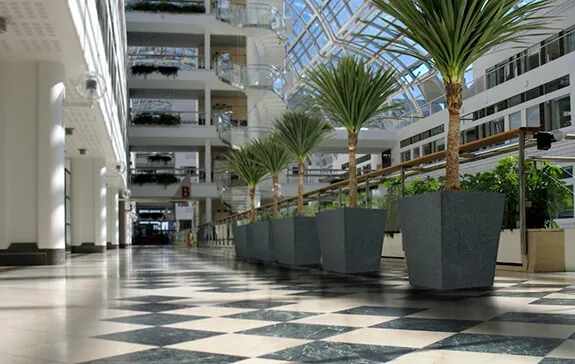
When choosing plants, take note of the following:
Consider Light. A pretty plant placed in an area with too much or not enough light will decline rapidly. Before specifying plants for interior containers, consult with the architects to learn the light conditions.
Chris Beardshaw is an award-winning British gardener, shares that high traffic areas and those adjacent to main pathways and terraces should allow sufficient light for easy access.
Consider the features you have already, and how you could use these to enhance the garden when lit – specimen plants, elegant planters and water features should all be enlivened when individually spotlighted.
Water Needs. Will someone water and groom the plants on a routine basis? Some plants need less maintenance than others.
Based on Location. Some plants provide a strong vertical accent, while others are trailing and well-suited for overhangs. Palms are ideal for adding height to interior gardens.
Some of Our Favourites for Indoor Container Planting
Peace Lily (Spathiphyllum)
Thrives in low to medium light conditions
Tolerates fluorescent lighting
Low maintenance and air purifying
Adds elegance with glossy green leaves and white flowers
Snake Plant (Sansevieria)
Very low maintenance and slow growing
Tolerates limited natural light or fluorescent lighting
Airpurifying qualities
Bold vertical leaves make a statement
ZZ Plant (Zamioculcas zamiifolia)
Extremely easy to care for
Tolerates low light and drought conditions
Attractive evergreen appearance
Adapts well to office environments
Chinese Evergreen (Aglaonema)
Versatile with striking foliage and vibrant colors
Thrives in low light and humidity conditions
Requires minimal watering and pruning
Easily adapts to room atmosphere
Janet Craig (Dracaena deremensis)
Adapts well to limited light conditions
Requires less water due to low light tolerance
Adds instant impact with lush, rich green foliage
Polishes up beautifully for a clean look
Kentia Palm
Performs well in moderate to bright indirect light
Adaptable to various office conditions
Graceful feather palm fronds make a statement
Suitable for floor pots or troughs
Selecting Plants for Outdoor Public Spaces
Many IOTA planters are placed in public spaces to add a touch of class, divide space, or provide scale to large public areas.
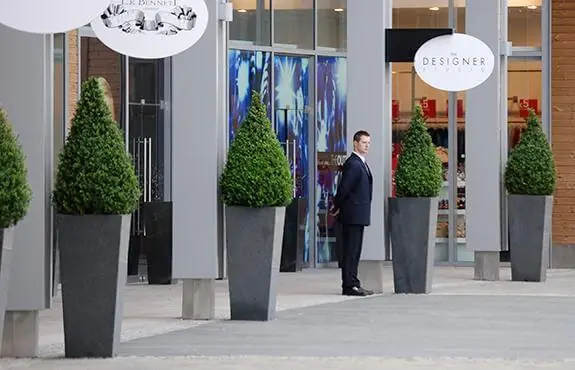
When selecting plants for public spaces, durability, low maintenance, and visual appeal are paramount. Here are some excellent choices:
Drought-Tolerant and Low-Maintenance Options:
Grevilleas: These Australian natives offer vibrant colors and require minimal care.
Banksias: Similar to Grevilleas, Banksias are hardy and provide visual interest.
Westringia: Known for its resilience and attractive foliage, Westringia is an ideal choice.
Rosemary: An aromatic herb that’s both beautiful and practical.
Lavender: Offers fragrance and colour while being relatively low-maintenance.
For Shade and Cooler Climates:
Ferns: Add a touch of elegance and require minimal direct sunlight.
Aspidistra: Known as the “cast iron plant,” it’s incredibly tolerant of neglect.
Hostas: Offer a variety of leaf shapes and colours, thriving in shade.
For Color and Impact:
Geraniums: Provide continuous blooms and come in a wide range of colours.
Petunias: Offer abundant flowers and are relatively easy to care for.
Verbena: Known for its vibrant colours and long flowering period.
Some of Our Favourites
Bird of Paradise (Strelitzia reginae)
Thrives in sunny gardens
Striking ornamental accent plant
Tough and suitable for hot, exposed, and windy spots
Requires a large, deep pot with good drainage
Dwarf Kangaroo Paw (Anigozanthos Bush Gems series)
Ideal for sunny gardens
Compact nature suitable for pots
Bred for superior flowering and performance
Needs well draining potting mix for native Australian plants
Kentia Palm (Howea forsteriana)
Adaptable to various light conditions
Elegant tropical appearance
Long lived and slow growing
Suitable for both indoor and outdoor use
Snake Plant (Sansevieria trifasciata)
Very hardy and low maintenance
Tolerates various light conditions
Requires minimal watering
Adds visual interest with striking vertical leaves
Peace Lily (Spathiphyllum)
Suitable for shady areas
Attractive glossy leaves and white flowers
Tolerates temperatures between 18°C to 27°C
Requires well draining soil and moderate watering
When using these plants in public spaces, consider the following tips:
Use large, sturdy containers with good drainage to ensure plant health and stability
Choose appropriate potting mixes for each plant type
Consider using self watering systems for easier maintenance
Place plants strategically to enhance the aesthetics of the space while ensuring they receive appropriate light
Regularly inspect and maintain plants to keep them healthy and attractive
These plants are well suited for public spaces in Australia because they are generally low maintenance, adaptable to various conditions, and can withstand the challenges of public areas while adding visual appeal.
Additional Considerations:
Plant size and growth habit: Consider the mature size of the plant and the space available.
Soil quality: Use a well-draining potting mix to prevent waterlogging.
Container size: Ensure the container is large enough to accommodate the plant’s root system.
Maintenance: Factor in the level of care required for each plant, considering the available resources for public spaces.
Plants to Avoid: Safety Risks
Plants with Physical Hazards
Cacti and succulents with sharp spines and can cause injuries, especially to children or visually impaired individuals. Plants with thorns (e.g. some roses, bougainvillea)
Giant Hogweed: Sap can cause severe burns or even blindness on contact with skin and sunlight.
Agaves: These majestic plants look great in any containers. However, unless you clip the large thorns off the ends of these plants, they pose a danger to pedestrians at eye-level.
Euphorbias: Some euphorbias are spiny, but all have poisonous milky sap. If someone who isn’t wearing gloves breaks off a piece of the plants and the sap gets on their skin, they can instantly develop a rash.
Toxic Plants
Oleander (Nerium oleander). Extremely toxic if ingested, with all parts of the plant containing dangerous cardiac glycosides. Oleandershould only be used in areas that see little foot traffic. Dwarf oleander would be well-suited to planters situated on rooftops or large walls, where people can’t get to their leaves and twigs.
Dieffenbachia: Moderately toxic to humans, dogs and cats. Can cause severe mouth and throat irritation if chewed.
Caladium. Toxic to humans, dogs and cats. Contains calcium oxalate crystals that can cause swelling and pain.
Philodendron. Mildly toxic to humans but more dangerous for pets. Can cause mouth and digestive irritation.
Allergy-Inducing Plants
Highly allergenic trees (e.g. certain types of oak, birch, cedar). Can trigger allergies in sensitive individuals.
Plants to Avoid: Mess
Fruit trees: These include ornamental fruit trees that do produce fruit. While they’re lovely and produce a nice crop to harvest, they’re also messy for public spaces.
Lilly Pilly: Although very hardy, the Lilly Pilly does produce fruits that can become messy and slippery when dropped on walkways.
Canna Lilies: These enormous perennials have large flowers that become unsightly as they turn brown, and will drop off of the plant and stain the sidewalk.
Bamboo: Needs a lot of maintenance and cleaning as it self prunes, but it is such a great screening plant it may well be worth the extra work.
Plants to Avoid: Fragility
The most fragile plant that is, unfortunately, used often in containers is the jade plant. Their leaves are easy to break off thus, it’s not recommended to use these plants where lots of young children can mess about with them.
Best Practices
Conduct a risk assessment of the space before selecting plants. Choose non-toxic, non-allergenic plants when possible. If using any potentially hazardous plants, place them in areas with limited access. Provide proper signage and information about plant species present. Regularly inspect and maintain plants to prevent overgrowth or other hazards. By avoiding these potentially dangerous plants and following best practices, you can create safer and more enjoyable public spaces. Always consult with horticultural experts or plant hire professionals when in doubt about plant selection for commercial or public areas.
Getting Creative – Design and Colour in Plant Selection
Make the plants “talk to each other.”
Follow this trick and you’ll be able to create container gardens that look like they were designed by a professional.
Planters are great places to try new plants and interesting colour combinations. Select a group of plants in which each plant has at least one colour in its leaves or flowers from another plant in the grouping.
The overall effect is much more harmonious:

Gardening expert Matt Biggs, from Gardeners World UK, shares how it’s essential to put the right plant in the right place to get the combination right, and achieve harmony.
It’s no good planting a shade lover next to a sun worshiper, or adding a plant that overpowers the rest. To look right, a pot should be about 1/3 of the height of the tallest plants.
Thrillers, Fillers, and Spillers
For BBC ‘Gardener of the Decade’, Katherine Crouch, every mixed container needs a thriller, a filler and a spiller.
For colour combinations, use two or three closely associated colours from one side of the colour wheel, and a small amount of complementary colour from the other side.
For instance, you can have a pot with a thriller red/brown cordyline, three fillers of deep purple (one) and flame red (two) osteospermums and a spiller of lime green helichrysum.
Container gardens need these three types of plants. Thrillers are the stand-out plants – bright, big flowers, or interesting berries. You only choose one thriller. It may be a topiary or standard rose, lavender plant, or evergreen.
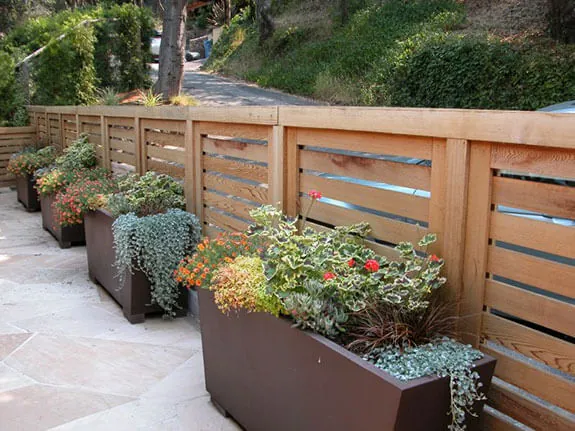
Conclusion
The careful selection of plants is paramount to the success of commercial and high-end residential container gardening in Australia. By considering factors such as climate, sunlight, soil type, and aesthetic preferences, you can create vibrant and thriving outdoor spaces that enhance the beauty and value of your property. Remember, with a little planning and attention to detail, container gardening can be a rewarding and enjoyable experience that transforms your surroundings into a botanical oasis.



0 Comments